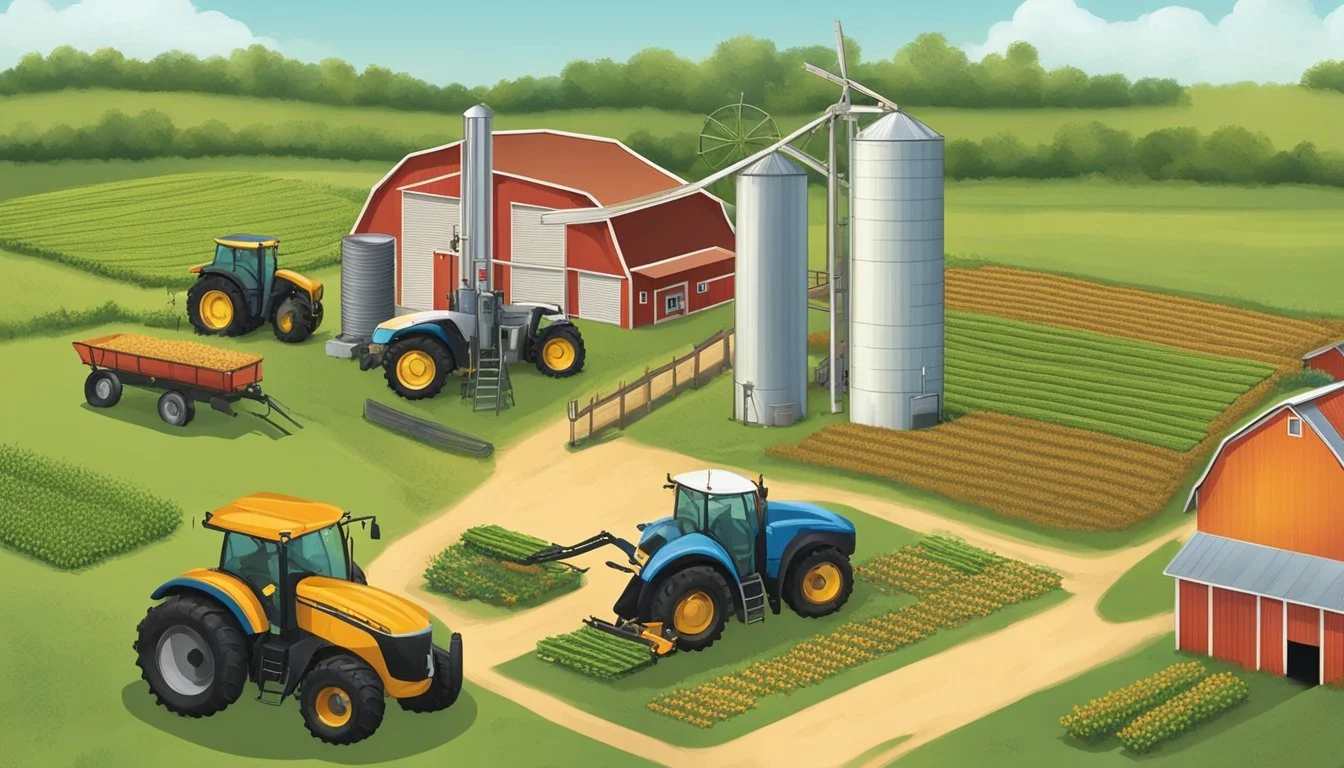Right to Farm Law in Florida
Understanding Agricultural Protections
The Florida Right to Farm Act, codified under Florida Statute § 823.14, serves as a cornerstone in safeguarding the interests and operations of the state's agriculture sector. Established with the intent to protect farming activities from nuisance lawsuits and excessive regulations, the act acknowledges the essential role of agriculture in Florida’s heritage and economy. It ensures that farmers can carry out their duties without undue interference, creating a more stable and predictable legal environment for the industry.
The importance of such legislation cannot be understated in a state where agriculture is a key player in the economy and society. With a diverse range of crops and livestock, Florida's farms contribute significantly to both the state's and the nation's food supply. The Right to Farm Act provides the necessary leeway for established agricultural activities to continue, reinforcing the state’s commitment to maintaining its agricultural heritage and future sustainability.
Modifications and updates to the Act, such as those signed into law by Governor Ron DeSantis, reflect ongoing efforts to modernize farming protections in line with current industry practices and challenges. These updates ensure that the Act remains relevant and effective in safeguarding farm operations against potential conflicts with urbanized areas and in establishing clear guidelines for permissible farming practices.
Historical Context and Purpose of the Right to Farm Law
Florida's Right to Farm Act was initially established in 1979, set against a backdrop of growing concern for the preservation of agricultural lands in the face of rapid urbanization. The principal aim was to defend the state’s farming operations from encroaching urban development and the nuisances often associated with such expansion.
The Act’s purpose is multifaceted:
To protect agricultural operations from nuisance lawsuits.
To assert the significance of agricultural production to Florida's economy and heritage.
To encourage the continuity and viability of farming operations within the state.
Agriculture is a cornerstone of Florida's economic framework, and as urban areas expand, farmers are confronted with increased legal challenges. The protections provided by the Right to Farm Act are a recognition of the importance of maintaining agriculture as a vital component of the state.
Historical development of the law reflects the evolving nature of agricultural practices and the necessary balance with populated areas. Recent amendments, as of July 1, 2021, illustrate the state’s enduring commitment to adapt legal protections meeting current agricultural challenges.
In essence, Florida’s Right to Farm law reflects a strategic response to safeguard the interests of farming operations by:
Codifying acceptable agricultural practices.
Offering a legal shield against non-agricultural development pressures.
Reducing the urban-rural friction through legislative means.
The historical trajectory of the Act showcases Florida's dedication to a robust and enduring agricultural sector amidst the inevitable tide of change.
Key Provisions of the Florida Right to Farm Act
The Florida Right to Farm Act is designed to safeguard farmers and ranchers from nuisance lawsuits, which potentially threaten the viability of agricultural operations.
Scope and Intent of the Act: The Act emphasizes the importance of agricultural production to Florida's economy and asserts the state's interest in protecting this sector. It conveys clear legislative intent to support farmers by establishing that those who comply with state regulations and employ best management practices are shielded from unfounded legal action.
Limitation on Lawsuits: One key provision includes strict limitations on the proximity within which a nuisance lawsuit may be brought against a farming operation. Only properties located within a half mile of the farm in question are permitted to file nuisance claims, significantly reducing the number of potential lawsuits.
Defenses for Farm Operations: The Act allows for robust defenses to protect farm operations. Farms are not held liable in certain scenarios, such as when the farming operation has been ongoing prior to the establishment of any nearby homestead or business, or when changed conditions in or around the locality of the farm after the operation began do not alter its right to farm.
Expansion Beyond Nuisance: Recently, the Act has been modernized to go beyond mere nuisance claims, indicating a broadening of legal protections for farmers. Notable amendments include definitions for terms like "agritourism activity" and "farm operation," which potentially extend the scope of protection.
It is imperative for both agricultural producers and neighboring properties to understand the parameters set by the Florida Right to Farm Act, to appreciate its role in balancing growth with the sustainability of farming practices.
Protection from Nuisance Lawsuits
The Florida Right to Farm Act shields farms from nuisance lawsuits under specific conditions, safeguarding agricultural operations against claims often associated with the inevitable byproducts of farming such as noise or odors.
Definition of Nuisance
A nuisance may involve noise, fumes, odors, or smoke originating from a property that infringes on another's enjoyment or use of their property.
Criteria for Protection
For a farm to be protected under the Florida Right to Farm Act, it must be a bona fide farm operation for over one year, not considered a nuisance upon establishment, and adhere to accepted agricultural practices.
Recent Amendments and SB 88
SB 88, signed into law on April 30, 2021, modernized the previous Right to Farm Act, clarifying the terms of protection for farming operations.
Nuisance Suit Defense Strategy
To defend against nuisance suits, farms present evidence that they meet statutory conditions. Successful defenses maintain agricultural land use against urban pressure.
Exceptions and Limitations
The Right to Farm Act does not protect actions that do not comply with state or federal environmental laws, among other exceptions.
Preeminent Role of Right to Farm in Land Use Disputes
The act serves as a critical defense in disputes, reinforcing the Agritourism Act and influencing zoning and land use decisions.
Impact of Right to Farm on Property Values
Courts consider the act's protections when evaluating claims regarding the negative impact of farm operations on neighboring property values.
Burden of Proof and Evidentiary Standards
Claimants must provide clear and convincing evidence in court to succeed in nuisance claims against farms.
Role of Nuisance in Land Development and Zoning
Nuisance claims can influence local governments' planning and zoning decisions as they navigate between agricultural and residential development needs.
Relationship Between Right to Farm and Environmental Regulations
The Right to Farm Act works in tandem with environmental regulations, enforced by entities like the Department of Environmental Protection and the Department of Agriculture and Consumer Services.
Litigation and Legal Precedents
Legal cases help define the applicability of the act, setting precedents for defenses against nuisance lawsuits, emphasizing the burden of proof, and clarifying legal protections.
Agritourism and Expansion of Right to Farm Protections
Agritourism activities benefit from Right to Farm protections, bolstering the economy by navigating the expansion of protection for diversified farm income sources.
Best Management Practices and Farm Operations
In Florida, Best Management Practices (BMPs) are integral to farm operations, balancing agricultural productivity with environmental protection.
Overview of Best Management Practices
Best Management Practices are a set of guidelines designed to optimize efficiency and minimize environmental impacts in farming operations. These practices provide frameworks for activities ranging from irrigation to pest control, aimed at conservation and sustainable land use.
Implementation and Compliance
Farm operations implement BMPs by adhering to the specific rules and manuals provided by the Florida Department of Agriculture and Consumer Services (FDACS). Compliance is essential for eligibility to certain protections and can influence the farm's regulatory standing.
Role in Defending Against Nuisance Claims
Under Florida's Right to Farm Act, adherence to BMPs offers a defense against nuisance claims. Operations following these guidelines for at least a year and not considered nuisances at the outset are generally shielded from litigation related to nuisance allegations.
Agriculture and Environmental Sustainability
BMPs are central to sustainable agricultural practices, focusing on water conservation and water quality protection. These practices help ensure that farm operations contribute to long-term environmental sustainability.
Impacts and Considerations for Neighboring Properties
The Florida Right to Farm Act limits nuisance lawsuits to properties within a half-mile of a farm and clarifies that BMPs aim to mitigate impacts on neighbors. This component protects farms while also acknowledging the interests of adjacent property owners.
Interaction with State and Federal Requirements
Farm operations must navigate both state and federal environmental regulations. BMPs often serve as the baseline for ensuring that these operations are in compliance with overarching environmental laws while maintaining their viability and productivity.
Economic and Social Impact of Right to Farm Laws
The enactment of Right to Farm laws in Florida has had a discernible impact on both economic and social landscapes, particularly within agricultural and rural domains. These laws provide farm operations with certain protections, aimed at preserving the agricultural sector's viability amidst urbanization pressures.
On the economic front, Right to Farm laws have been instrumental in safeguarding farmers from nuisance lawsuits, thus financially stabilizing farm operations. By reducing litigation risks, these laws help ensure that farms remain economically feasible and competitive. For instance, the amended Right to Farm Act, signed into law in 2021, specifically supports Florida's farmers by limiting the conditions under which they can be sued, subsequently protecting farm revenues and investments.
Rural areas have indirectly benefited from such legislation. The stability it provides to farming operations contributes to maintaining the economic backbone of these communities. With agriculture as a critical industry in Florida, the laws help sustain not only the farms but also the local economies that are integrated with or reliant upon agricultural success.
In terms of social impacts, the Right to Farm laws have at times been a point of contention. Protective of farmers, the laws can come into conflict with the interests of residents who may be affected by farming activities. However, these laws also aim to preserve the agricultural heritage and ensure that farming—often a family tradition—can endure against developmental pressures.
The balance between safeguarding farming operations and managing social implications remains at the heart of the Right to Farm laws, with the intent to foster a thriving agricultural sector while also considering the welfare of broader communities.
Role in Protecting Florida's Agricultural Heritage
Florida's Right to Farm Act serves as a crucial shield for the state's agricultural heritage, safeguarding legacy farming communities against legal pressures that could undermine their operations. The state of Florida recognizes the vital role that agriculture plays, not only economically but also culturally, preserving a way of life that has developed over generations.
Key Protections:
Defense against nuisance lawsuits, particularly in areas where urbanization encroaches upon farmlands.
Limitations on local government regulations interfering with farm operations.
The historical significance of farming in Florida cannot be overstated—it is a tapestry of crop diversity woven into the land over centuries. The right to farm law protects this diversity, ensuring that farming practices can continue unfettered by the expansion of neighboring cities and suburbs.
By legislating these protections, the state underscores its commitment to legacy farming communities. It legitimizes their enduring presence amidst a rapidly changing landscape. Florida's farms contribute to the state's identity and economy, and by upholding the Right to Farm Act, lawmakers signal a resilient stance in favor of this foundational industry.
Historical Significance:
Since 1979, the Right to Farm Act has been elemental in protecting the agricultural heritage.
The law reflects an evolution of farming's role and reflects the societal values placed on food production and rural life.
This legal framework provides a certainty for farmers, who can invest in and cultivate the land, confident that their legacy and way of life are recognized and respected.
Analysis of Right to Farm in the Context of Urban Sprawl
The rise of urban sprawl in Florida has markedly increased the tension between agricultural and non-agricultural land use. Right to Farm Laws (RTFL) in Florida, such as the Amendment Governor DeSantis signed into law on April 30, 2021, have ramifications on this evolving landscape.
Florida's RTFL was modified to further support agricultural practices amidst expanding urban development — underscoring the friction between maintaining farmland and the demand for residential and commercial space. The law's amendments can be seen as a shield for agricultural lands, affirming a farmer's right to operate without the pressure of new non-agricultural neighbors pushing for change.
This dynamic remains complex as agricultural lands are increasingly engulfed by suburban extensions, placing farmers in a defensive position. Florida's RTFL:
Prioritizes historical agricultural land use
Protects farmers from nuisance lawsuits arisen due to encroaching developments
Seeks to mitigate the conflicting interests between existing farms and new non-agricultural developments
By asserting the "first in time, first in right" principle, the law establishes a precedence of use that benefits established farms. However, the saturation of agricultural lands with suburban expansion has added a layer of challenges pertaining to land use changes.
The intricate balance between preserving agriculture and accommodating urban growth is an ongoing struggle. As Florida's urban footprint widens, the RTFL serves as a pivotal tool in governing the competition with non-agricultural development, striving to ensure that agricultural enterprises can endure the pressures of urban sprawl.
Future of Right to Farm Legislation
Legislative changes in Florida’s Right to Farm Act reflect a trend toward reinforcing agricultural activities against nuisance lawsuits. With an amending bill signed into law, SB 88, Florida has proactively worked to shield its agricultural producers. The future of this legislation likely involves periodic reviews and potentially further amendments to ensure it remains relevant and effective in the face of evolving agricultural practices and urban expansion.
Future perspectives suggest that as population growth continues to put pressure on rural areas, there may be an increase in the need for protections afforded by the Right to Farm Act. Policymakers are expected to monitor the outcomes of these laws and potentially consider the balance between farming operations and residential interests.
From a policy standpoint, the emphasis could shift toward accommodating new farming technologies and methods that are sustainable and environmentally friendly. The act’s future revisions might address the intersection of agricultural practices with environmental concerns, ensuring that its protections do not come at the cost of ecological health.
In summary, Florida’s Right to Farm legislature is likely to evolve with a focus on:
Maintaining a balance between farm protection and nuisance prevention,
Incorporating environmental stewardship into farming practices,
Ensuring compatibility of the legislation with new and emerging agricultural technologies.
The trajectory of the Right to Farm legislation will be shaped by the state's ability to adapt to these demands while maintaining its dedication to the agriculture sector.
Conclusion
The Florida Right to Farm Act protects legitimate agricultural operations from nuisance lawsuits, affirming the significance of agriculture to the state's economy and way of life. The act serves to encourage sustainable farming practices by offering certainty and stability to farmers, fostering a precedent for long-term growth in the agricultural sector.
Recent amendments to the act highlight Florida's commitment to preserving its agricultural legacy. By extending protections and clarifying operations classified as bona fide, it ensures that farming practices can evolve with technological advancements while maintaining a balance with community interests.
Potential long-term implications of the act include:
Safeguarding of Food Resources: It could fortify Florida’s position in securing its own food resources and contribute to the overall resilience of the local food supply.
Environmental Considerations: Sustainable practices are encouraged, enhancing environmental stewardship and potentially leading to more innovative approaches to modern farming.
Legal Precedents: The law may influence legal decisions in other jurisdictions, possibly altering the legal landscape for agricultural operations nationwide.
Ultimately, the Florida Right to Farm Act represents a crucial legislative measure. It supports the agricultural community while promoting responsible and forward-looking farming practices. By establishing a clear legal framework, it aims to protect the state's agricultural heritage and pave the way for a more sustainable agricultural future.









